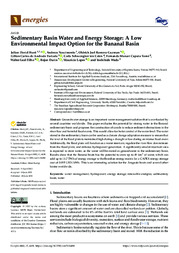Sedimentary Basin Water and Energy Storage: a low environmental impact option for the bananal basin.
Sedimentary Basin Water and Energy Storage: a low environmental impact option for the bananal basin.
Author(s): HUNT, J. D.; NASCIMENTO, A.; GUZMAN, O. J. R.; FURTADO, G. C. de A.; CATEN, C. S. T.; TOMÉ, F. M. C.; LEAL FILHO, W.; DURIN, B.; LOPES, M. A.; WADA, Y.
Summary: Groundwater storage is an important water management solution that is overlooked by several countries worldwide. This paper evaluates the potential for storing water in the Bananal sedimentary basin and proposes the construction of canals to reduce sediment obstructions in the river flow and harmful flood events. This would allow for better control of the water level. The water stored in the sedimentary basin can be used as a climate change adaptation measure to ensure that the level of the flood plain is maintained high during a drought or low during an intense flood event. Additionally, the flood plain will function as a water reservoir, regulate the river flow downstream from the flood plain, and enhance hydropower generation. A significantly smaller reservoir area is expected to store water, as the water will be stored as groundwater in the sedimentary basin. Results show that the Bananal basin has the potential to store up to 49 km3 of water, which can add up to 11.7 TWh of energy storage to the Brazilian energy matrix for a CAPEX energy storage cost of 0.095 USD/kWh. This is an interesting solution for the Araguaia basin and several other basins worldwide.
Publication year: 2022
Types of publication: Journal article
Unit: Embrapa Agroenergy
Observation
Some of Embrapa's publications are published as ePub files. To read them, use or download one of the following free software options to your computer or mobile device. Android: Google Play Books; IOS: iBooks; Windows and Linux: Calibre.
Access other publications
Access the Agricultural Research Database (BDPA) to consult Embrapa's full library collection and records.
Visit Embrapa Bookstore to purchase books and other publications sold by Embrapa.

